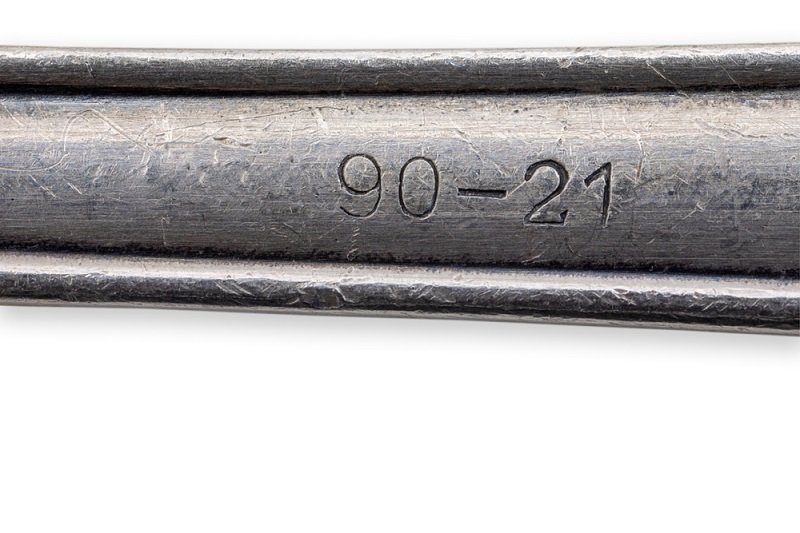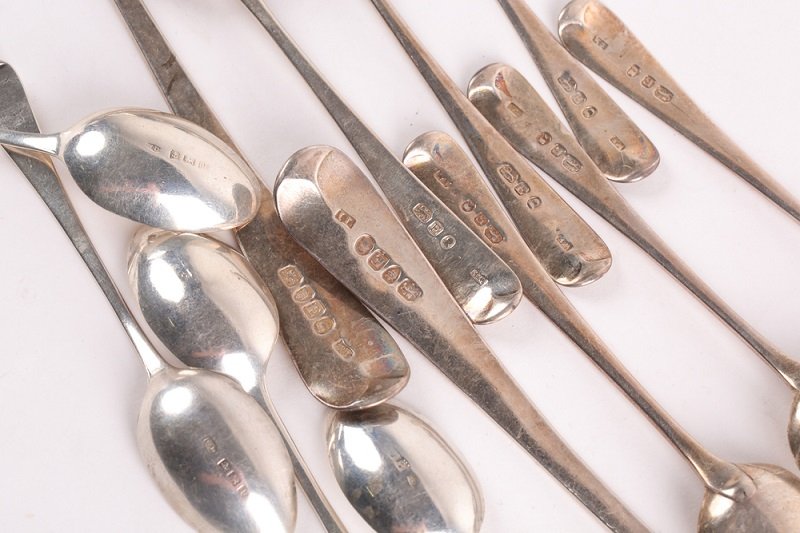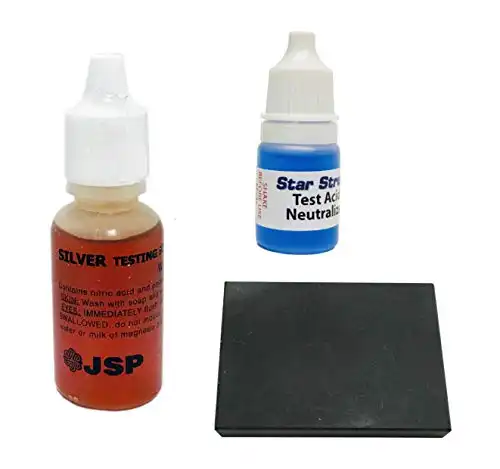One of the most common things for newbies to ask about is various types of scrap metal and whether or not they can be melted down and used further. Silverware is a great example, especially since it’s readily available in many areas.
So, let’s take a look and see if silverware is really a good fit for silversmithing choices, and how to make the right call with your flatware.
Check the Hallmarks First
There are about a hundred different types of silverware meant to look like silver. Most of us are aware that a lot of it isn’t silver.
So you’ll have to identify what you’re working with.
I ran a resale business for some time, and a common thing for people to bring to me was silverware. I had to tell more than one person that their loved one’s silverware… wasn’t silver, or worth anything at all really.
We’ll talk about acid testing a bit further down, but most flatware can be checked without needing to break out the PPE and nitric acid.
The marks you’re looking for are sterling marks. These vary depending on the country of origin, but they’re the best way to know before you start cutting things down. It doesn’t hurt to have common ones memorized if you’re dealing with this sort of thing often.

The vast majority of “silver” flatware you run across is going to be silver-plated. The stamps are sometimes close to those meant for sterling.
You’ll run into a few further complications as well.
Knives, for instance, almost always have a steel blade stuck into a silver handle. Your saw or shears will note the difference quickly, but it can be disappointing… especially if you offered some amount of spot value for a lot of silverware.
Checking the hallmark is the first step in making sure what you have is the right material for the job. You can recover the silver from plated objects, but you’d need pounds of material to get any kind of reasonable return and it’s often a hazardous task.

Acid Testing Unmarked Material
I’ll be blunt here: unless the piece you’re looking at was so heavily used the hallmarks actually wore off, you probably don’t have anything worth melting on your hands.
That’s not to say it doesn’t happen, but after going through a few dozen pounds of silver flatware over the course of a couple of years I only had to acid test material twice. On the other hand, I have used this method for trays, cups, and other larger pieces more than once.
The testing process is simple, but you’ll need a pre-mixed solution. The linked kit has a test stone, but you can use any unglazed ceramic instead. The bottom of an unused coffee cop works well, for instance.
From there:
- Put on gloves and goggles. Silver testing solutions are a mix of hydrochloric and nitric acid.
- Scratch your piece of silver on the ceramic or testing stone. Silver plating will show issues at this point, as the metal won’t create an even streak.
- Place a small amount of acid on the streak, just enough to cover it.
- Wait for the reaction.
- Ideally, you’ll end up with a red streak on the plate, this indicates sterling silver. Bright red will be fine silver, while brown is usually in the 80-90% range.
- Neutralize the solution with either the included neutralizer or with water supersaturated with baking soda.
This simple test can save you a lot of time, but it can backfire if you’re too softhanded and the item is plated. You need to scrape hard enough that you’re not just putting the very top layer on the stone.
Acid testing is also done for gold alloys, but that’s a more in-depth topic and requires several tightly calibrated solutions to determine the gold’s purity.
An acid test is a good thing to have around for anyone who works with silver. It’s your best bet for at-home testing.
Should I Melt Down My Silver Flatware?
The answer is a solid maybe.
Here’s the thing: silver is a commodity so it’s worth what the market dictates. In many cases, you can retrieve 80-90% spot by just going to a precious metals dealer.
But the added value on top of the silver spot price comes with a lot of variety. Old antique sets may be worth an easy 200-400% of spot value for the metal, while particularly valuable sets raise prices to the point the metal doesn’t even touch the true price.
You should always identify and research flatware you’re planning to meltdown before you get started. You may save yourself from making a very costly error with a couple of quick Google searches.
If you regularly bring old silverware into the shop, it can pay off to know which ones are selling for very high prices. Like all things antique, it’s a complicated matter. Most newbies will be able to figure out if they’re making a huge mistake with a few minutes of research, however.
So, I Can Melt Down Silverware?
Absolutely, as long as the material is silver you’re good to go.
I do recommend keeping some fine silver casting grain on hand. It’s invaluable for keeping the silver at hallmarked standards, and a few grains can help smooth out any problems that occur during the melt. This is doubly important if you’re working somewhere that requires formal assays.
For the most part, the process is simple.
Prepare the silverware for your kiln, torch, or preferred melting matter first. Pull the blades from knives and saw the handles in half to remove any filler material, cut down forks and spoons so that they’ll fit in your crucible or mold as well.
Then it’s just a matter of applying enough heat to cause it to melt and pouring the resulting mass into an ingot mold or allowing it to cool depending on your equipment.
Some tips for melting at home:
- If you’re using a smaller torch, you may need to get creative in order to keep enough thermal energy in for a proper melt.
- Raise the metal to the boiling point, not just the melting point. You need a couple of seconds to act and pour the metal.
- Preheat ingot molds. Steel should be heated a decent amount but doesn’t need to be red hot. Graphite will turn a bit lighter as you torch it, which is moisture being removed from the mold and it doesn’t need any more heating.
- Start with a small amount if you’ve never melted silver before. You need to be able to identify how silver melts to know what you’re doing.
I don’t recommend bothering to melt the metal if you’re going to send it to a refiner. You’ll get the same or better return just by sending in the items that you were planning on melting.
How Can I Use My Ingot?
If you’re not selling the material after you’ve made the ingot, you may wonder just how to use the material in front of you.
There are a lot of ways to do things at this point:
- Hammer and stretch the ingot by forging to create something.
- Hammer the ingot or blob into sheet metal. Just smack it with a hammer repeatedly and anneal whenever the metal stops moving.
- Use a rolling mill to make wire or sheet.
It’s just a big chunk of material after all.
The point of the matter is that you can turn that sterling silver flatware into anything that you have the time, skill, and tools to make.
The only difference between buying bullion and melting down some silver at home is the markings.
- Online rock and mineral club for collectors of all levels!
- Find community with like-minded rock and mineral enthusiasts.
- Monthly Giveaways!
- Free Access to Entire Digital Library of Products (annual memberships)



